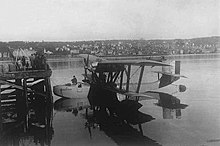"Logical form and logical equivalence"
Consider
(i) Admundsen flew to the North Pole.
Logical form?
Grice, following Reichenbach's suggestion, proposes, only to refute it later:
(R) (Ex)(x consists in the fact that Admundsen flew to the North Pole.
Yet,
(R) above "does not give the correct logical form" of (i)
---
Why?
Because (R) is about an event, while (i) in is not.
So [(R) cannot give the logical form of (i).
Consider now:
ii.
A flight by Admundsen to the North Pole took place.
(ii) IS about an event and might be formalised by (R).
---
The idea is whether it is fair to associate (R) as the logical form of
i.
Admundsen flew to the North Pole.
Grice comments:
"IF, as Reichenbach thinks, I am provided with a pair of this or that logically equivalent expression, one of which is about an event, while the other is not, THAT CRUCIAL DIFFERENCE might justly be held to be reason for
DENYING (or rejecting)
that the EVENT-mentioning expression, (R)
gives or provides or is the logical form
of the other expression of the pair of this, now allegedly, logically equivalent expressions."
---
Grice proposes that, as an *emendation* of Reichenbach, and indeed, to reject Davidson's analysis.
Aerial Expeditions to the North Pole[edit]
The 1923 attempt to fly over the Pole failed. Amundsen and Oskar Omdal, of the Royal Norwegian Navy, tried to fly from Wainwright, Alaska, to Spitsbergen across the North Pole. When their aircraft was damaged, they abandoned the journey. To raise additional funds, Amundsen traveled around the United States in 1924 on a lecture tour. Although he was unable to reach the North Pole, the scientific results of the expedition, mainly the work of Sverdrup, have proven to be of considerable value. Much of the carefully collected scientific data was lost during the ill-fated journey of Peter Tessem and Paul Knutsen, two crew members sent on a mission by Amundsen. The scientific materials were later retrieved by Russian scientist Nikolay Urvantsev from where they had been abandoned on the shores of the Kara Sea.[18]
In 1925, accompanied by Lincoln Ellsworth, pilot Hjalmar Riiser-Larsen, flight mechanic Karl Feucht and two other team members, Amundsen took two Dornier Do J flying boats, the N-24 and N-25, to 87° 44′ north. It was the northernmost latitude reached by plane up to that time. The aircraft landed a few miles apart without radio contact, yet the crews managed to reunite. The N-24 was damaged. Amundsen and his crew worked for more than three weeks to clean up an airstrip to take off from ice.[19] They shovelled 600 tons of ice while consuming only one pound (400 g) of daily food rations. In the end, the six crew members were packed into the N-25. In a remarkable feat, Riiser-Larsen took off, and they barely became airborne over the cracking ice. They returned triumphant when everyone thought they had been lost forever.
In 1926, Amundsen and 15 other men (including Ellsworth, Riiser-Larsen, Oscar Wisting, and the Italian air crew led by aeronautical engineer Umberto Nobile) made the first crossing of the Arctic in the airship Norge, designed by Nobile.[20] They left Spitsbergen on 11 May 1926, flew over the North Pole on 12 May,[21] and landed in Alaska the following day.
Controversy over Polar Priority[edit]
The three previous claims to have arrived at the North Pole: Frederick Cook in 1908; Robert Peary in 1909; and Richard E. Byrd in 1926 (just a few days before the Norge) are disputed by some, as being either of dubious accuracy or outright fraud.[22][23] If these other claims are false, the crew of the Norge would be the first explorers verified to have reached the North Pole, floated over it in the Norge in 1926.[4][21] If the Norge expedition was the first to the North Pole, Amundsen and Oscar Wisting were the first men to have reached both geographical poles, by ground or by air.
Disappearance and death[edit]
This section does not cite any sources. (February 2019) (Learn how and when to remove this template message)
|
Amundsen disappeared on 18 June 1928 while flying on a rescue mission in the Arctic. His team included Norwegian pilot Leif Dietrichson, French pilot René Guilbaud, and three more Frenchmen. They were seeking missing members of Nobile's crew, whose new airship Italia had crashed while returning from the North Pole. Amundsen's French Latham 47 flying boat never returned.
Later, a wing-float and bottom gasoline tank from the plane, which had been adapted as a replacement wing-float, were found near the Tromsø coast. It is believed[by whom?] that the plane crashed in fog in the Barents Sea, and that Amundsen and his crew were killed in the wreck, or died shortly afterward. The search for Amundsen and team was called off in September 1928 by the Norwegian government, and the bodies were never found.
In 2004 and in late August 2009, the Royal Norwegian Navy used the unmanned submarine Hugin 1000 to search for the wreckage of Amundsen's plane. The searches focused on a 40-square-mile (100 km2) area of the sea floor, and were documented by the German production company ContextTV.[24][25] They found nothing from the Amundsen flight.





No comments:
Post a Comment